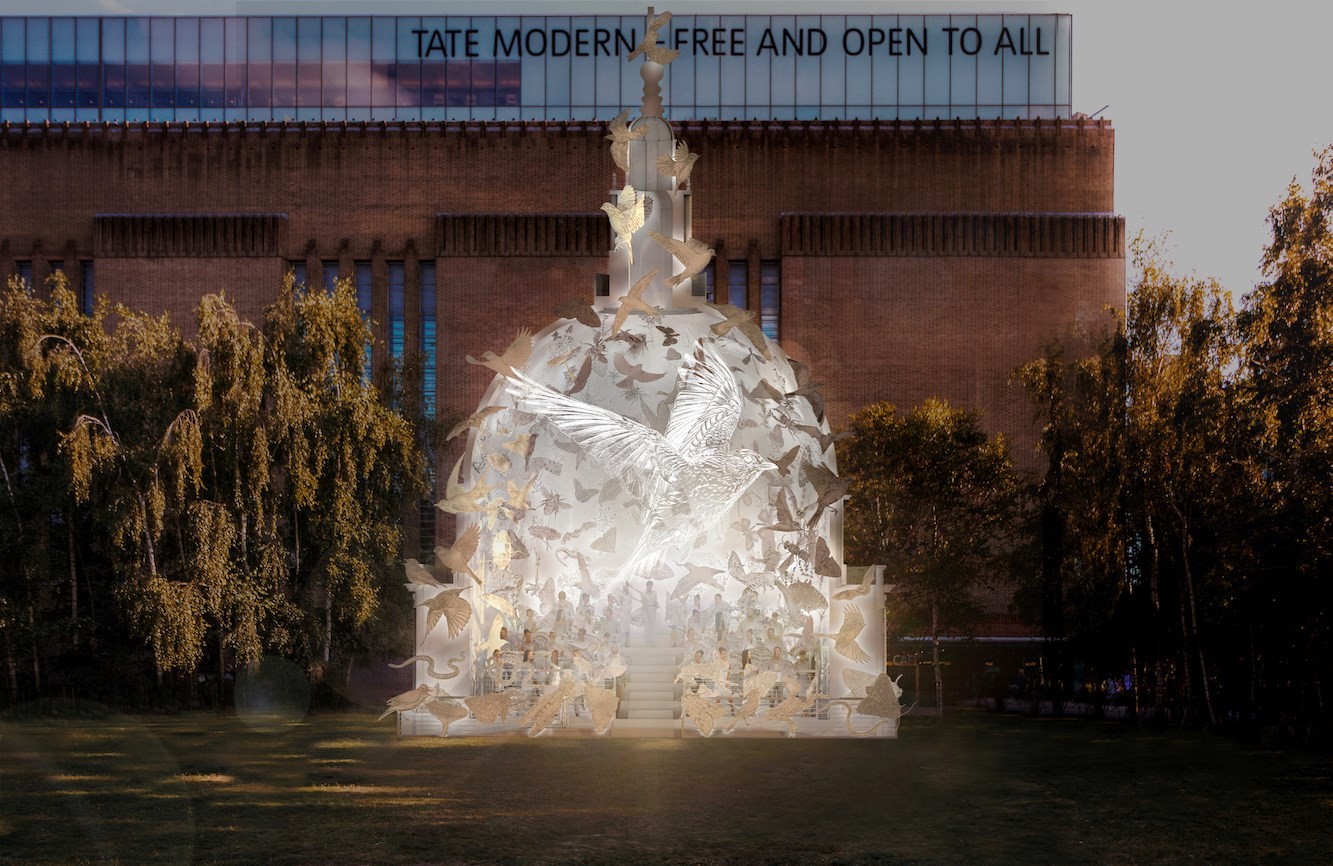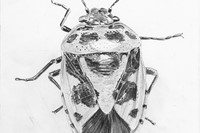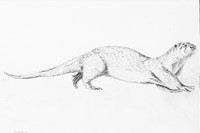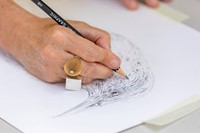Es Devlin is a byword for wonderment. When Saint Laurent designer Anthony Vaccarello wanted to create a spectacle for his Morocco-staged fashion show, he turned to Devlin, and the two of them imagined an oasis out of which rose a fiery halo – a mystical, futuristic spectacle, a portal for transcendence. Aside from blowing the minds of audiences with her stadium-shuddering installations for Kanye West, Miley Cyrus, Beyoncé, U2 and The Weeknd, Devlin has been slowly and steadily building a reputation for public artworks; site-specific, temporary installations that transform our sense of reality.
Devlin’s work is rooted in transmutation and self-reflection, with strong political and social convictions. Take Please Feed The Lions, where she asked “what would happen if the lion of Trafalgar Square could speak?” and used her skill in projection-mapping to bring them to life with amazing conceit; the public then submitted text which an AI transformed into a continuous poem that unfolded from the lions’ mouths. In Superblue Miami, she presented her Mirror Maze which brought visitors into direct confrontation not just with their own reflection but also with their breath through a series of curved and mirrored corridors that echoed the organic geometry in nature to that of our lungs. More recently, for Forest of Change, Devlin planted a variety of 400 different trees in the bare stone courtyard of Somerset House, bringing the conversation around rewilding and conservation front and centre at London Design Week. All the trees were later planted across London boroughs, with the carbon footprint and circularity of her design materials becoming an increasingly integral part of her practice.
Come Home Again, which was commissioned by Cartier and will be exhibited in the garden of Tate Modern this September, is described as an “illuminated choral sculpture” – a temple of convening inspired by the dome of St. Paul’s Cathedral. With nightly Evensong performances, the installation will become home to a series of diverse choirs who will raise a spiritual note of warning about our loss of biodiversity. Devlin has also identified 240 endangered London animals that she has drawn and plans to animate on the facade; it’s another Es Devlin portal, another transformational experience, and yet another stage-set for wonderment and learning.
Jefferson Hack: Tell me about Come Home Again?
Es Devlin: It began with London; with thinking, ‘Who’s a Londoner?’ and trying to expand the sense of that term, because there are 15,000 species in London that are not human. And that’s not even counting the absolute myriad – at least 10,000 species – that live inside each human, that are not human: the microbes, the bacteria that live inside us.
JH: How did you begin your research into that?
ES: The person who recommended me the two most important books in my life is the Amazon algorithm. I was recommended two books by David Abram which have changed my life: Becoming Animal and The Spell of the Sensuous. Another inspiration for this project was a book by Joanna Macy called World as Lover, World as Self. I had been researching ecophilosophy and I actually often start my research by looking at Olafur Eliasson’s bibliography because he’s so generous on his Instagram with his bookshelf. So I thought, ‘Well, if Olaf has been reading this, I’m going to try that.’ And I was reading various books about biomimicry by Janine Benyus, when the Amazon algorithm said, ‘If you bought that, you might like this.’
“With Somerset House, you’d always walk through that courtyard; this big, very beautiful piece of geometry, but so human-dominated with a decree that says ‘No trees here, please.’ What if forests could grow there? What if you could have the birds?” – Es Devlin
In a nutshell, what Joanna says is that it’s a very arbitrary place to delineate the edge of yourself on the edge of your epidermis. Think about your mouth: the air comes in, it’s your air, it’s part of yourself, the air goes out, it’s connected with all the molecules that have been breathed over time by Charlie Chaplin, Cleopatra, you, anyone in this room. It’s just a finite amount of atoms that have been breathed by everyone. I had already made this piece of work – Forest of Us at Superblue in Miami – which was a really simple exercise in pointing out the geometrical and mathematical symmetry between a tree inside you, your bronchial tree, and a tree outside you.
What if I went further than just noticing the symmetry between my bronchial tree and the tree outside me? And what if I could encourage others to do the same? I researched London species and found that there are 15,000 different species [of trees] living in this city. I thought,‘Well, that’s interesting, but it’s too many to really get people to engage with them in meaningful ways.’ I went online and found a list called ‘the London priority list’; those are the species that are considered most in need of imaginative engagement, so we’ve partnered with the London Wildlife Trust.
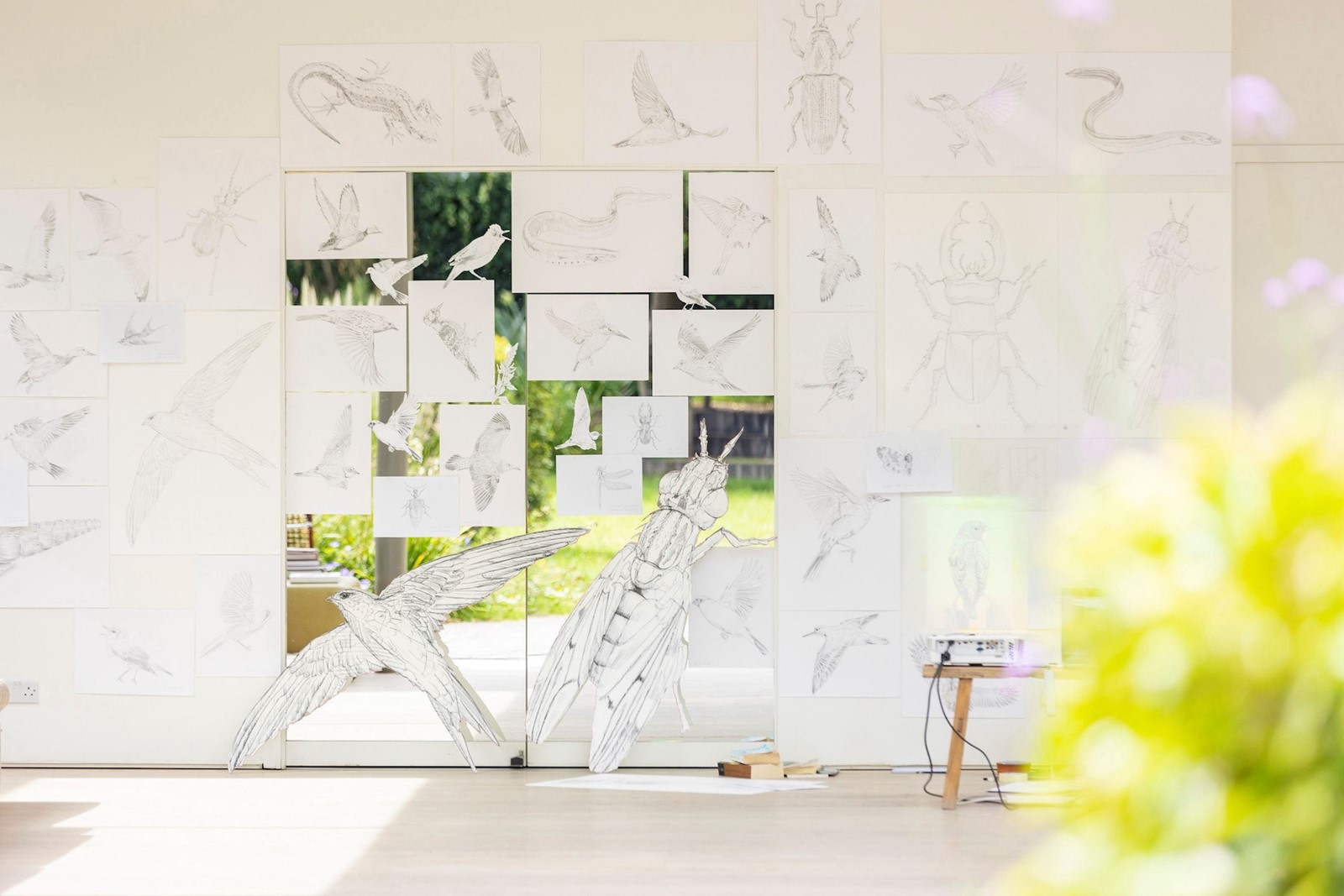
JH: What does imaginative engagement mean?
ES: We need hooks in our brain to hang things on. So once we learn their name, then we are changing the architecture of our brain. We’re rewilding our brains to a degree …
JH: And we’re building empathy.
ES: We are building empathy and connection. I thought, ‘How can I make people actually absorb the ideas? There’s no point in me teaching it.’ One thing we know from Timothy Morton is: don’t bother preaching, amaze people. How do we amaze people? Music. How do you really amaze people? Choral music. So I went and sat at Evensong in St Paul’s, which by the way, anyone can do any night of the week for free. You just walk in at five o’clock, and you will be surrounded by the most breathtaking talents, and it’s not a performance, it’s a ritual. The distinction being that those people will sing at five o’clock, whether anyone turns up or not. They’re doing it just to tell the time of the day. You know, the call to prayer. And it happens all over London.
So I thought, ‘Well, how can I make people feel like that? That sense of wonder about a great sense of self, this expanded sense of expansion.’ I wanted to go back to that quality of total artwork that a church was. That gave me hope, that was a time where that was quite normal. Robert Hooke and Christopher Wren were doing experiments. When they built The Monument to the Great Fire of London, that is a zenith telescope inside it, they didn’t want to waste effort just building a memorial. So they said, ‘Oh, let’s put a telescope in it.’
JH: How does this new project link to the one you did at Somerset House? Because you’ve had significant London moments; you had the Trafalgar Square lions, then the trees at Somerset House.
ES: Yes, they’ve been a continuum of works. Trafalgar Square was really about saying, ‘This lion that you’ve walked past for years, that’s been sitting there just part of your environment. You’ve never considered that it could speak, but actually, what if the lion could? What if that stone had a voice and could speak back to you and tell you everything it thought? And what if you could help it by feeding it words?’
And again, with Somerset House, you’d always walk through that courtyard; this big, very beautiful piece of geometry, but so human-dominated with a decree that says ‘No trees here, please.’ What if forests could grow there? What if you could have the birds? We had Brian Eno’s Birdsong, which really brought to life the birds that he and his colleagues had been recording for years.

JH: I love all the succession of what ifs. What’s the ‘what if’ that you’re obsessing about right now
ES: What if we could extend the edges of ourselves? Because you need that, with the situation we’re in now, it’s so easy for us and any of the people reading this to get overwhelmed. We need acupuncture points like, ‘What is the single thing I could do that might resonate the most?’
JH: What’s the acupuncture point that you’re working on?
ES: It is to invite everybody to extend the sense of where their self ends. If being selfish actually applies to a much broader sense of self that incorporates every plant in this garden, and every animal, then fine, feel as selfish as you want. Joanna Macy, who wrote the book that is most obsessing me, World as Lover, World as Self, was a systems theorist. She used to work for the CIA and then she got sent to Vietnam and ended up taking a Buddhist path. Her doctorate was written on the overlay of Buddhist thought and systems theory. James Lovelock was talking precisely about that, that’s all that Gaia is, it’s systems theory. There’s a system and we are part of that system. And actually Stefano Boeri, who’s the wonderful architect who’s making these extraordinary skyscrapers of trees, he said, ‘What a useless place to define the edges of yourself. It is useless.’
“It’s been absolutely proven that you will have a better conversation if you’re sat next to a tree, your brain will behave in a better way” – Es Devlin
JH: Will Come Home Again be an acupuncture point?
ES: Yes! What will happen each night for ten nights is choirs will come and sing. And the birds and the insects will also sing. There’ll be a solo for a herring gull, or there’ll be a solo for a cuckoo. Then I’m going to do some readings. So it does sort of take the form of Evensong. And there are biodegradable, sustainable rain ponchos ready for everyone in case the weather breaks, we don’t care. We’ll be outside, literally in between St Paul’s, which is beautiful but closed, and our St Paul’s, which is sliced open and teeming with these 243 animals.
JH: If you could have a conversation with one of the animals that you’ve drawn, which one would you choose?
ES: It’s got to be that tall fescue planthopper because it’s so beautiful. If I saw it down here, I’d probably think it was the tiniest little louse and go and comb my daughter’s hair. But in fact, when you zoom into it, it’s the most elegant, extraordinary dinosaur Zooming into things that are different scales, because we can only see our own, rather narrow band of scale. And if we can zoom in on the scale of pace for plants, and watch them blooming, then we can recognise the geometry in them. Because as a kid, I was scared of moths. So again, you have to undo that kind of fear.
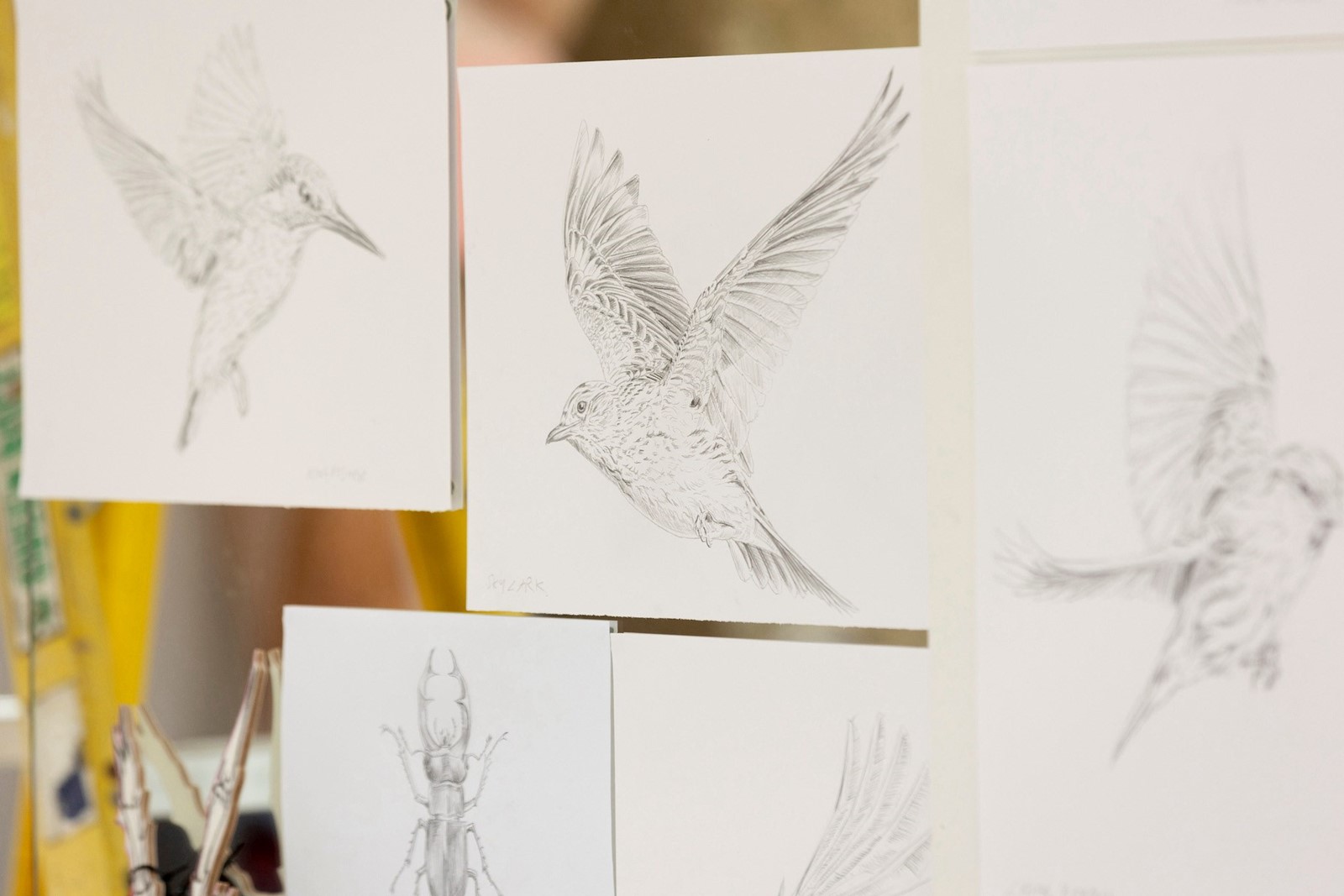
JH: The fear of the other, the fear of nature. Fear of wild places. Fear of wild animals.
ES: My children are scared of getting their feet dirty sometimes. How would you undo that?
JH: You mentioned a lot of writers and a lot of great references. I wanted to ask you about the indigenous leaders that you met at COP26.
ES: There are two in particular called Célia Xakriabá and Sonia Guajajara.
JH: First of all, what were you doing at COP26?
ES: I made an artwork at The New York Times Climate Hub which was an extension of the work we did at Somerset House. We had read Richard Powers’...
JH: The Overstory, yeah ...
ES: The Overstory suggests that you can write a 600-page great American novel, of which the protagonists are not human. They are trees. And you have to have some humility and patience to read it as a human because you are secondary. And you’re not used to that in a novel. But if you stick with it, you realise, actually, there are these amazing protagonists of trees, and you have to get into their timescale.
I thought, ‘What if – just like we do with these 197 countries that are coming to have a conference, what if we made a conference of the trees in parallel?’ So each of those delegates had an equivalent tree. And what if we recognise that these trees were bearing witness to what we were going to discuss and decide? So we planted these 197 trees indoors, and it smelled amazing because it’s been absolutely proven that you will have a better conversation if you’re sat next to a tree, your brain will behave in a better way.
JH: Because there’ll be more oxygen, more chemicals ...
ES: Indeed, phytoncides which you can particularly smell if you’re near a pine or cedar are released by trees, and they will reduce your stress levels while increasing your sleep levels and T-cell activity. You will have a better chance to fight off cancer. From there, you have stuff like the Japanese shinrin yoku tree bathing. There’s tonnes of research now proving people that have better, higher urban tree canopy cover have a better lifespan and all this.
We thought, ‘Instead of going to sit in a conference room with this kind of lighting, a screen and chairs, what if we made it somewhere more conducive?’ and everyone came to speak in there. There’s a call to action at the end of Superblue, which says, ‘If you have $8, go to the Instituto Terra and plant a tree.’ So what I think about the Indigenous leaders I met at COP is that they have big followings on Instagram and they are rock stars. Wouldn’t it be great if our children aspired to be like them? Rather than jet-bouncing or whatever ...
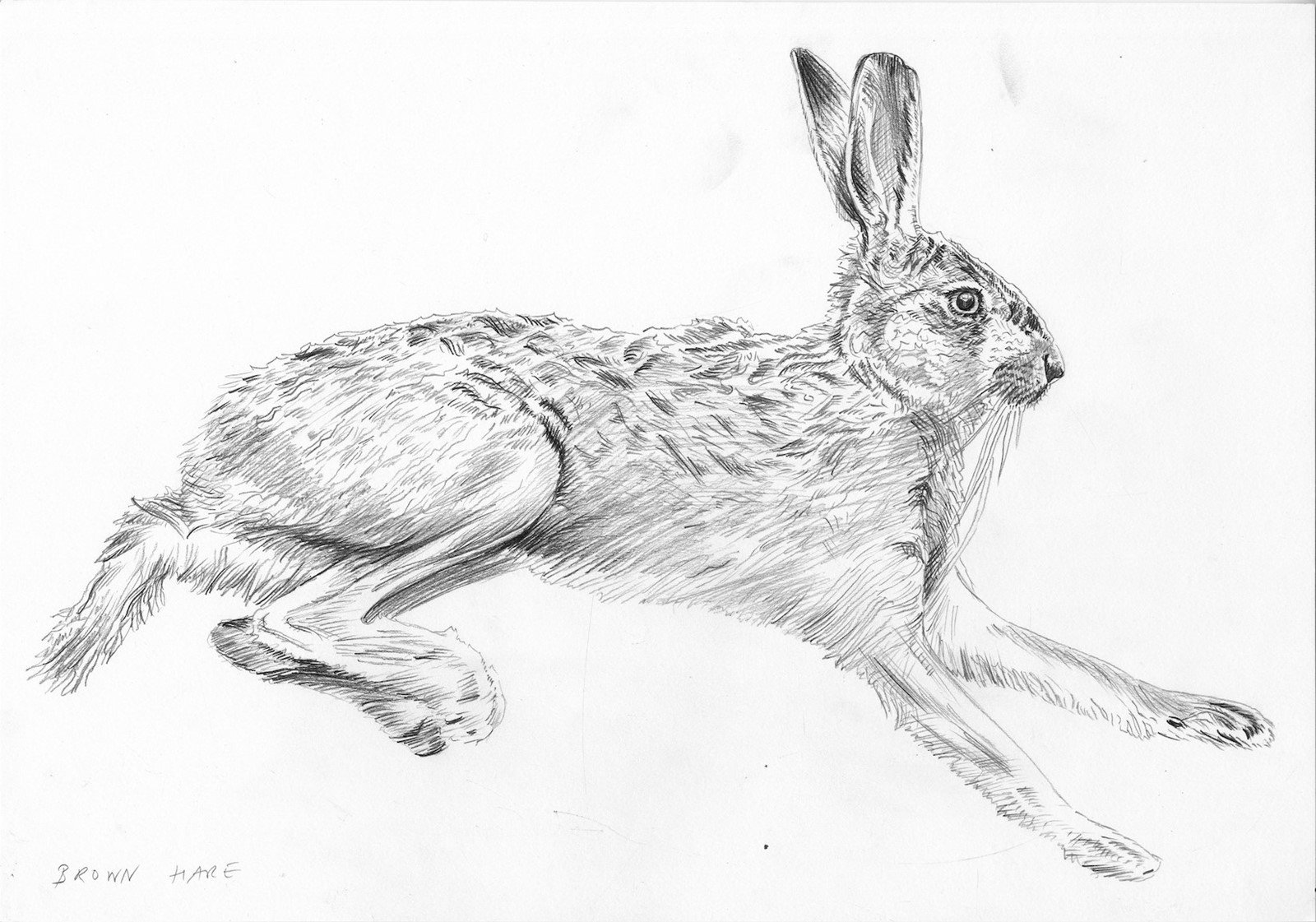
JH: During the pandemic, the big conversation was to use this opportunity to reframe our relationship to nature; to have a great slowing down in terms of carbon consumption, fossil fuel extraction, assessing the way exhibitions are put together and how fashion shows are presented. Now that we have emerged, do you feel like everything’s just gone back to normal? Or do you think behaviour has changed?
ES: I think the latter, for sure. In every room that I’m in, I feel so much more emboldened to open my mouth, and say, ‘We can’t do it this way, we need to do it that way.’ And I find that the other people in the room are either relieved and thrilled that I’ve opened my mouth, or they’re about to do it themselves, anyway.
Take, for example, the beautiful Saint Laurent piece that we just did, which is this big, beautiful ring that rose out of a well in the desert. Clearly there’s further to go because you might say in the future, ‘We won’t be doing shows like that where people come out to a desert to watch a show.’ But that said, the first conversation is, ‘How do we reduce the footprint of this? How are we going to do something this ambitious?’ and Bureau Betak had it all worked out and versions of the show were rejected because it was going to require too much impact on that place.
“I am looking at what Olafur Eliasson is doing, because I think he has now committed to no air travel at all for the studio. I think all of his installations will be done by Zoom, and all of his works will be transported by either boat or train. So that’s the next generation” – Es Devlin
Could we do better by not even going there? Yes, but in terms of how we’re doing it, we absolutely hold each other to account. And for my studio, there is a carbon audit that goes on for the whole year. And anything that I can’t mitigate, will go into [Sebastião] Salgado’s project. But I am looking at what Olafur Eliasson is doing because I think he has now committed to no air travel at all for the studio. I think all of his installations will be done by Zoom, and all of his works will be transported by either boat or train. So that’s the next generation. And that’s about an attitude to time, because we do as much train travel as we can, but we need to work out the time schedule of that so that we can build time into work on the train.
JH: What are the other intentions behind Come Home Again?
ES: It’s a call to action. I think there’s a lot of work around climate change that says, ‘Look at this, this is beautiful, we’re about to lose it,’ or ‘look at this, this is on fire,’ and do you feel a responsibility? If you’re going to call someone’s attention to something, you need to give them a way in, a portal. Thing one is: learn the names; it’s a really simple invitation to learn the names of these animals – here’s a QR code, have a look and learn their names. Thing two is: here are ways you can connect with the London Wildlife Trust and help conserve these animals.
Come Home Again by Es Devlin, in collaboration with Cartier, will go on show at Tate Modern’s garden from Wednesday, September 21 to Saturday, October 1, 2022.
